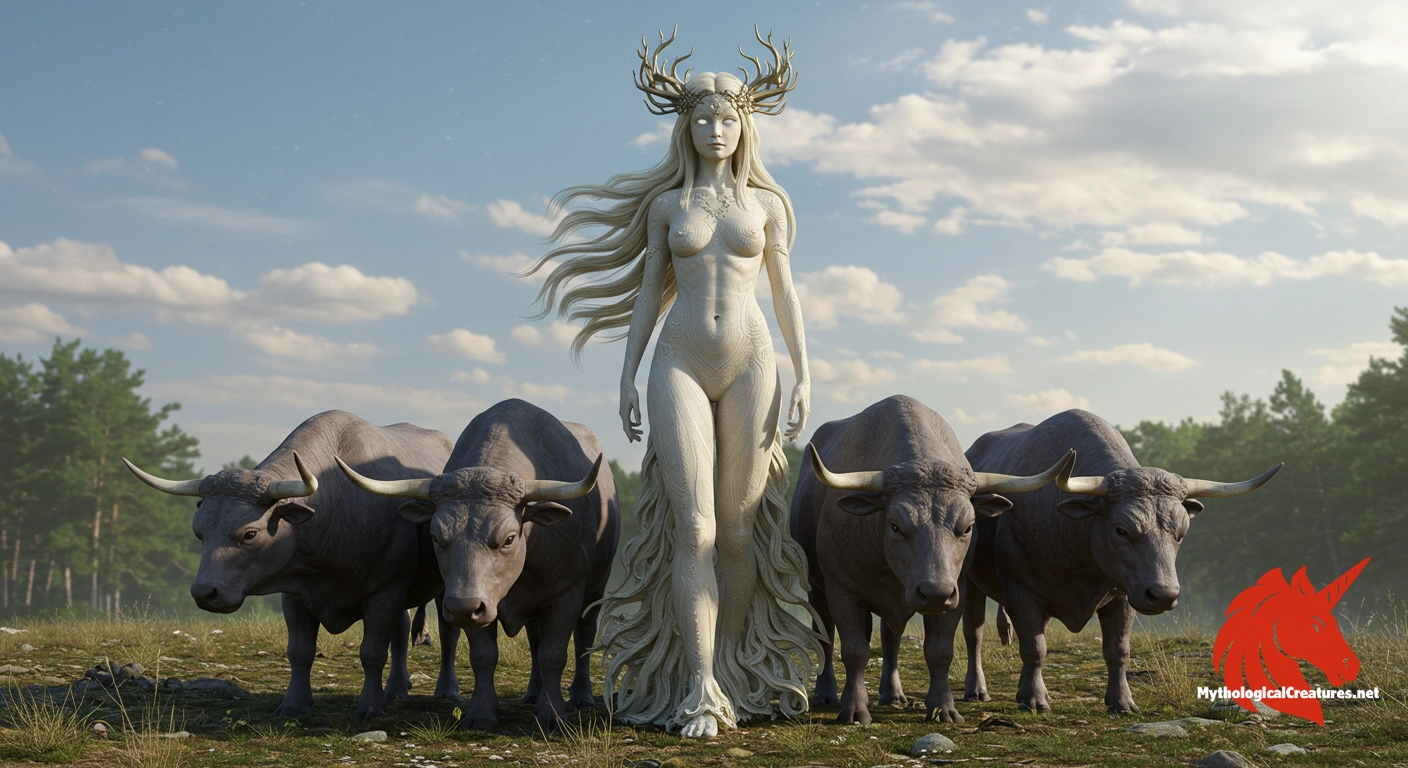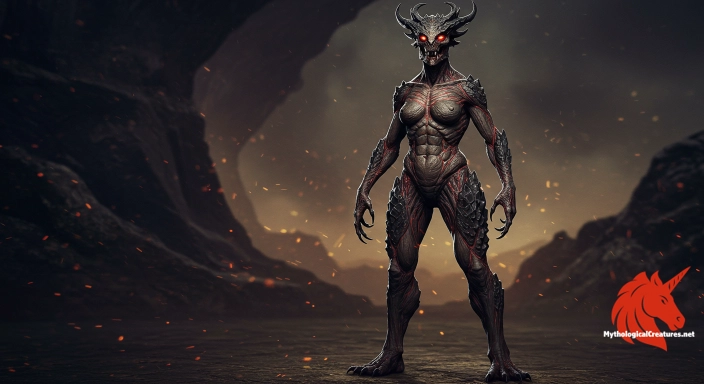Gefjon: Gefjon is a Norse goddess renowned for her association with ploughing and the creation of land.

Gefjon
Gefjon - Central to Norse agricultural mythology; credited with the transformation of Lake Mälaren into the island of Zealand and associated with virginity and prophetic insight
Origins & First Encounters
Gefjon is a multifaceted goddess from Norse mythology who embodies the forces of transformation and fertility. Her roots lie deep within the Scandinavian mythic tradition, where she is celebrated for her extraordinary connection to the land and its bountiful harvests. Early attestations in the Poetic Edda and Prose Edda hint at her ancient significance and vivid presence in the mythic landscapes of the North. Her narrative intertwines the purity of virginity with the potency of creative energy, positioning her as both an untarnished maiden and a powerful agent of change. One of her most famous exploits involves reshaping the natural world by ploughing away a vast expanse of water to form the island of Zealand, an act that symbolises the divine power to mould nature. Her association with foreknowledge further enhances her complex character, suggesting a deep insight into the cycles of life and nature. Communities across Scandinavia have long revered her as a patroness of agriculture, celebrating her role in ensuring fertile soil and prosperous harvests. Connections with legendary figures such as the kings Gylfi and Skjöldr weave her seamlessly into the heroic and regal tapestry of Norse lore. Her enduring myth serves as a testament to the intimate relationship between divinity and the natural world. Even today, Gefjon remains a symbol of both fertility and sovereignty, embodying themes of renewal, transformation, and the eternal rhythm of nature.
Source Texts & Tale Variants
Literary sources that mention Gefjon offer a richly layered mosaic of narrative fragments and detailed accounts. The Poetic Edda presents her in lyrical snippets that evoke images of her transformative power and connection to the earth’s fertility. The Prose Edda, on the other hand, provides a more expansive narrative, recounting vividly the legendary episode of her ploughing away lake Mälaren to create land. Heimskringla adds further depth by integrating her tale into the broader saga of legendary kingship and divine intervention in human affairs. Skaldic verses contribute subtle allusions to her attributes, particularly highlighting the juxtaposition between her virginity and her dynamic creative force. In certain medieval manuscripts, Gefjon is even drawn into a cross-cultural dialogue, appearing as a gloss for various Greco-Roman goddesses, which underscores her versatility as a mythic persona. Variants of her story sometimes emphasise her solitary divinity, while other versions highlight her marital union with key legendary rulers. These differing accounts reflect the fluid nature of oral tradition and the multiple layers that have shaped her legacy over time. Each source contributes its own nuances to her myth, ensuring her status as a figure of both mystery and enduring cultural importance. The patchwork of original texts and later interpretations continues to inspire scholarly debate and imaginative retellings.
Form & Powers
Descriptions of Gefjon’s physical form are few in the earliest sources, yet artistic and literary traditions have later adorned her with a striking and memorable appearance. In many visual depictions, she emerges as a youthful and radiant figure whose countenance reflects both formidable strength and gentle grace. Artists often portray her with long, flowing hair that cascades like golden fields under the summer sun, evoking the very essence of agrarian fertility. Her eyes are imagined as deep and luminous, mirroring the reflective quality of still water and the vigour of the earth. Periodic iconography sometimes incorporates hints of oxen or plough imagery within her attributes, subtly reinforcing her link to agricultural prosperity. The garments that drape her form are rendered in earthy tones and rich, natural textures, symbolising the connection between the goddess and the land. Although early texts are reticent about her anatomy, later cultures imagined her as a paragon of divine femininity and strength. Each artistic interpretation not only captures her mythic attributes but also reflects the evolving ideals of beauty and power in the culture. Through these evocative images, Gefjon is transformed into an emblem of nature’s renewal, where every detail of her portrayal resonates with symbolic meaning. Such imaginative renderings ensure that her divine presence remains both timeless and vividly tangible in the collective imagination.
Regional Faces
Gefjon’s myth is not static but shifts subtly as it travels across different regions of Scandinavia. In Danish tradition, she is celebrated as a foundational figure whose divine labour led to the creation of significant land, symbolising a sacred bond between the people and the very earth they inhabit. Swedish interpretations tend to focus on her dramatic act with lake Mälaren, echoing local themes of loss, renewal, and environmental transformation. These regional narratives highlight the adaptability of her persona to local geographical features and cultural priorities. In some local sagas, her image is presented as that of an untarnished virgin goddess, while in others, her relationship with legendary kings infuses her story with elements of royal authority. Variations in her portrayal mirror the diverse agricultural practices and spiritual beliefs of different Scandinavian communities. Festivals, folklore, and place-names continue to honour her legacy, attesting to her integral role in regional identity. Even as the narrative shifts from one locality to another, the central themes of fertility, transformation, and sovereignty remain consistent. The fluidity in her character demonstrates how myth evolves to meet the needs and values of distinct communities. Thus, Gefjon serves as a vibrant testament to the interplay between local tradition and shared mythic heritage across Scandinavia.
Cultural Parallels
Gefjon’s attributes resonate well beyond the boundaries of Norse mythology, drawing intriguing parallels with other agricultural and transformational deities across cultures. Her role as a creator of land finds a clear echo in the Greek goddess Demeter, whose dominion over the harvest and the nurturing of life is similarly celebrated. Comparable attributes can also be found in the Roman goddess Ceres, who personifies the cycle of growth and renewal. Within the Norse pantheon herself, she shares thematic commonalities with goddesses such as Freyja and Frigg, who embody both elements of fertility and the mysterious dimensions of destiny. This convergence of themes across different mythological systems suggests a shared instinct to deify the forces of nature. Her depiction as a virgin who commands nature aligns with broader Indo-European traditions where purity and creative power are interwoven. The narrative of moulding a new land from water also finds resonance in myths where order is extracted from chaos, a common motif in ancient storytelling. The fluid boundaries between the roles of a nurturer and a sovereign in her character further cement her place among universal archetypes of regeneration. Comparative studies reveal that while cultural details may differ, the underlying narrative of transformation and renewal is a unifying thread. In this way, Gefjon emerges as a bridge between diverse mythic traditions, celebrated for her timeless embodiment of nature’s cyclical energies.
Legacy & Modern Evolution
The evolution of Gefjon’s myth mirrors the dynamic interplay between ancient traditions and modern reinterpretations. While her early depictions in medieval texts centre on her agricultural prowess and transformative feats, contemporary retellings frequently emphasise her symbolic relevance in themes of regeneration and environmental stewardship. Her legendary act of reshaping the landscape continues to inspire artists, writers, and cultural practitioners who see in her a timeless emblem of nature’s evolutionary processes. Modern art and literature frequently draw upon her imagery to highlight the enduring bond between humanity and the natural world. In academic and popular discourse alike, she is celebrated not only as a figure of myth but also as an icon of independent strength and renewal. As global interest in sustainable practices and ecological balance grows, Gefjon’s legacy as a guardian of the earth gains renewed resonance. Her transformation from a local agricultural deity to a symbol of universal natural cycles speaks to the enduring power of myth in adapting to contemporary concerns. The interplay between tradition and modernity in her character continues to invite reinterpretation, allowing her story to evolve with the times. Today, her name endures in cultural landmarks and seasonal festivals, ensuring that the spirit of ancient Norse wisdom lives on. Through these layers of reinterpretation, Gefjon remains a vibrant and accessible emblem of both mythic heritage and modern ecological consciousness.
Interesting Fact
An interesting aspect of Gefjon is that her myth has evolved over time, intertwining agricultural fertility, royal lineage, and prophetic insight, thereby reflecting the dynamic interplay of culture and nature in Norse tradition.
Quick Creature Info
Origin:
Associations:
Our Mythic Legendary Rating:

Also Sometimes Known As:
Habitat:
Supernatural Powers:
Physical Attributes:
Abilities:
Behavior:
Lore:
References
Discover Another Mythical Legend You May Not Have Heard Of?
Uncover the mysteries of ancient folklore and expand your knowledge of legendary beings from cultures around the world.
Dare to Meet the Campe....
Mythical Disclaimer: The images and data on this site are derived from various historical and literary sources, but we have found that many myths often have multiple versions and interpretations across references, sometimes contradictory. As a result, these creature depictions are artistic interpretations—imaginative blends of folklore, legend, and a dash of AI guesswork. Because creature descriptions vary widely, our illustrations and accompanying information represent our best effort to honor mythology while bridging creative gaps. Enjoy these interpretations—just remember, we've done our best to respect the stories and validate available data, but in the realm of mythology, details often shift, imagination leads the way, and nothing is ever set in stone!
Curated by the Mythological Creatures Team (rev. May 2025)
